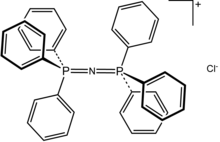Bis(triphenylphosphine)iminium chloride
 |
|
| Names | |
|---|---|
|
IUPAC name
μ-nitrido-Bis(triphenylphosphorus) chloride
|
|
| Other names
PPN chloride
Bis(triphenylphosphine)iminium chloride Bis(triphenylphosphoranylidene)iminium chloride Bis(triphenylphosphoranylidene)ammonium chloride Hexaphenyldiphosphazenium chloride Selectophore |
|
| Identifiers | |
|
3D model (JSmol)
|
|
| ChemSpider | |
| ECHA InfoCard | 100.040.139 |
|
PubChem CID
|
|
|
|
|
|
| Properties | |
| C36H30ClNP2 | |
| Molar mass | 574.03 g/mol |
| Appearance | colourless solid |
| Melting point | 260 to 262 °C (500 to 504 °F; 533 to 535 K) |
| moderate | |
| Hazards | |
| R-phrases (outdated) | 36/37/38 |
| S-phrases (outdated) | 26–36 |
| Related compounds | |
|
Related compounds
|
Tetraphenylarsonium chloride Tetrabutylammonium chloride tetrabutylammonium chloride |
|
Except where otherwise noted, data are given for materials in their standard state (at 25 °C [77 °F], 100 kPa).
|
|
|
|
|
| Infobox references | |
Bis(triphenylphosphine)iminium chloride is the chemical compound with the formula [(C6H5)3P)2N]Cl, often written [(Ph3P)2N]Cl and abbreviated PPNCl. This colorless salt is a source of the PPN+ cation, which is used to isolate reactive anions. PPN+ is a phosphazene.
PPNCl is prepared in two steps from triphenylphosphine:
This triphenylphosphine dichloride is related to phosphorus pentachloride. Treatment of this species with hydroxylamine in the presence of Ph3P results in replacement of the P-Cl bonds by P=N bonds:
In PPN+ salts, P-N bond lengths are equivalent, 1.58 Å. The cation is bent at the central nitrogen, and has no inversion centre. Its connectivity is indicated by Ph3P+–N––P+Ph3, which explains non-linear arrangement of P-N-P moiety owing to sp3-hybridization of the nitrogen center. Alternative depiction Ph3P=N=PPh3+ would imply sp-hybridization at N-atom and thus linear structure.
In the laboratory, PPN chloride is the main precursor to PPN+ salts. Using salt metathesis reactions, nitrite, azide, and other small inorganic anions can be obtained with PPN+ cations. The resulting salts PPNNO2, PPNN3 etc. are soluble in polar organic solvents.
PPN+ forms crystalline salts with a range of anions that are otherwise difficult to crystallize. Its effectiveness is partially attributable to its rigidity, reflecting the presence of six phenyl rings. Often PPN+ forms salts that are more air-stable than salts with smaller cations such as those containing quaternary ammonium or alkali metal cations. This effect is attributed to the steric shielding provided by this voluminous cation. Illustrative PPN+ salts of reactive anions include PPN[HFe(CO)4], PPN[Co(CO)4], and PPN[Fe(CO)3NO]. The role of ion pairing in chemical reactions is often clarified by examination of the related salt derived from PPN+.
...
Wikipedia
